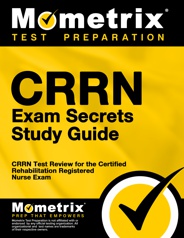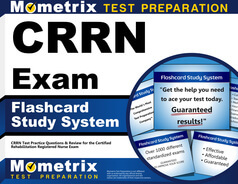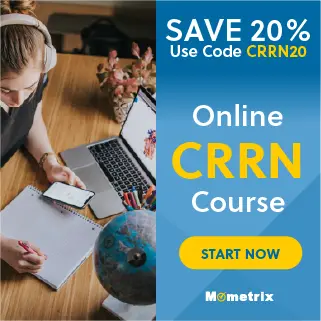The Certified Rehabilitation Registered Nurse (CRRN) exam is administered by the Rehabilitation Nursing Certification Board (RNCB) to assess the general knowledge and skills of prospective rehabilitation nurses.
Click “Start Test” above to take a free CRRN practice test!
Exam Eligibility
To be eligible for the exam, you must meet all of the following requirements:
- You must hold a current and unencumbered RN license
- You must have completed at least two years of professional RN practice in rehabilitation nursing, OR one year of practice and one year of advanced nursing studies
CRRN Exam Outline
The CRRN exam contains 175 multiple-choice questions, 25 of which are unscored, and you will be given a 3-hour time limit. The RNCB uses the unscored questions to identify which questions are suitable for future versions of the exam.
The exam is split into four content domains. Each domain contains some number of tasks, and each task contains a set of knowledge-based questions and a set of skills-based questions.
I. Nursing Models and Theories (8%)
There are two tasks in this domain:
Knowledge
- Nursing process
- Nursing models and theories that pertain to rehabilitation
- Rehabilitation standards and scope of practice
Skills
- Application of the nursing process
- Application of rehabilitation nursing models and theories
- Application of rehabilitation standards and scope of practice
Task 2: Incorporate pertinent nursing models, research, and theories to individualized patient care.
Knowledge
- Evidence-based research
- Related theories and models
- Nursing process
- Nursing models and theories that pertain to rehabilitation
- Rehabilitation standards and scope of practice
- Patient-centered care
Skills
- Application of the nursing process
- Application of rehabilitation nursing models and theories
- Application of rehabilitation standards and scope of practice
- Incorporation of evidence-based research into practice
II. Functional Health Patterns (53%)
There are eight tasks in this domain:
Knowledge
- Pharmacology
- Technology
- Physiology
- Rehabilitation standards and scope of practice
- Health, injury, acute and chronic illness, and adaptability management
Skills
- Management of health and wellness by teaching interventions
- Use of technology
- Assessment of health practices and health status
- Use of rehabilitation standards and scope of practice
- Assessment of sexuality and reproduction goals
Task 2: Promote optimal psychosocial patterns, as well as coping and stress management skills.
Knowledge
- Cultural diversity
- Psychosocial disorders
- Community resources
- Traditional and alternative modalities
- Safety concerns
- Coping and stress management strategies
- Stages of loss and grief
- Theories
- Types of stress and stressors
- Physiology of the stress response
Skills
- Use of therapeutic communication
- Assessment of potential for harm to others and self
- Promotion of positive interactions
- Assessment and promotion of self-efficacy, self-concept, and self-care
- Facilitation of appropriate referrals
- Incorporation of cultural awareness and spiritual values
- Implementation and evaluation of strategies to reduce stress and improve coping
- Accession of supportive team resources
- Inclusion of the patient in the plan of care
Task 3: Optimize the patient’s functional abilities.
Knowledge
- Assistive devices and technology
- Safety concerns
- Anatomy, physiology, and interventions pertaining to cardiovascular, musculoskeletal, respiratory, and neurological function
- Self-care activities
- Activity tolerance
- Energy conservation
- Clinical signs of sensorimotor deficits
Skills
- Use of technology and assistive devices
- Assessment and implementation of interventions pertaining to cardiovascular, musculoskeletal, respiratory, and neurological complications
- Prevention of complications and immobility
- Implementation of safety interventions
- Assessment, implementation, and evaluation of self-care and mobility interventions
Task 4: Optimize the management of the patient’s neurological and other medical conditions.
Knowledge
- Pharmacology
- Pain
- Central lines
- Measurement tools
- Safety concerns
- Catheters
- Measurement tools
- Neuroanatomy and physiology
Skills
- Teaching of strategies for pain and comfort management
- Assessment of cognition, perception, preservation, pain, sensation, and apraxia
- Use of medical equipment and technology
- Implementation and evaluation of strategies for safety
- Teaching of strategies for neurological deficits
- Teaching of central line, port, and catheter care and purposes
Task 5: Optimize the patient’s ability to communicate effectively.
Knowledge
- Linguistic deficits
- Cultural diversity
- Anatomy and physiology
- Communication techniques
- Developmental factors
- Assistive technology and adaptive equipment
Skills
- Use of communication techniques
- Assessment of comprehension and communication
- Involvement and education of support systems
- Use of assistive technology and adaptive equipment
- Teaching of self-advocacy skills to caregivers and patients
- Implementation and evaluation of communication interventions
Task 6: Promote optimal nutrition and hydration.
Knowledge
- Anatomy and physiology pertaining to metabolic and nutritional patterns
- Pharmacology
- Diagnostic testing
- Nutritional requirements
- Adaptive equipment
- Feeding techniques
- Cultural and religious practices related to diet
- Diet types
- Skin integrity
- Enteral and parenteral nutrition and hydration
- Fluid and electrolyte balance
- Safety concerns and interventions
Skills
- Use of adaptive equipment
- Assessment of nutritional and metabolic patterns
- Implementation and evaluation of skin integrity interventions
- Use and management of mechanical and manual devices to provide nutrition and hydration
- Teaching of swallowing deficit interventions
- Implementation and evaluation of nutrition interventions
Task 7: Optimize the patient’s elimination patterns.
Knowledge
- Bladder and bowel adaptive equipment and technology
- Anatomy and physiology
- Pharmacological and non-pharmacological interventions
- Bladder and bowel training
Skills
- Use of adaptive equipment and technology
- Assessment of elimination patterns
- Teaching of interventions to prevent complications
- Implementation and evaluation of bladder and bowel management interventions
- Provision of patient and caregiver education
Task 8: Optimize the patient’s sleep and rest patterns.
Knowledge
- Technology
- Pharmacological and non-pharmacological sleep aids
- Factors affecting sleep and rest
- Physiology of sleep and rest cycles
Skills
- Evaluation of sleep and rest intervention effectiveness
- Assessment of sleep and rest patterns
- Use of technology
- Promotion of sleep and rest interventions and strategies
III. The Function of the Rehabilitation Team and Transitions of Care (12%)
There are two tasks in this domain:
Knowledge
- Rehabilitation definition and philosophy
- Related theories
- Goal-setting and expected outcomes
- Role of the rehabilitation nurse and other team members
- Models of healthcare teams
Skills
- Communication and collaboration with the interdisciplinary team
- Development and documentation of care plans
- Application of appropriate theories
- Appropriate delegation of team-member responsibilities
Task 2: Promote the patient’s community reintegration or transition to the next level of care.
Knowledge
- Professional resources
- Technology and adaptive equipment
- Personal and community resources
- Teaching and learning self-advocacy strategies
- Different levels of care
- Care continuum
Skills
- Assessment of community reintegration barriers
- Discharge planning
- Assessment of discharge readiness
- Accessing community resources
- Teaching of health, wellness, and life skills maintenance
- Facilitation of appropriate referrals
- Evaluation of outcomes
- Adjustment of goals
- Participation in team and patient caregiver conferences
IV. Legislative, Economic, Ethical, and Legal Issues (27%)
There are five tasks in this domain:
Knowledge
- Specific legislation related to rehabilitation and disability
- Agencies related to disability, regulations, and rehabilitation
Skills
- Use of standardized assesment tools
- Interpretation and application of legal, regulatory, and accreditation information
Task 2: Deliver cost effective patient- centered care.
Knowledge
- Community and public resources
- Utilization review processes
- Insurance and reimbursement
- Clinical practice guidelines
- Staffing patterns and policies
- Regulatory agency audit processes
- Patient-centered care
Skills
- Management of current and projected resources in a cost-effective manner
- Analysis of the quality and utilization of data
- Incorporation of clinical practice guidelines
- Documentation that supports regulatory requirements
- Collaboration with private, public, and community resources
Task 3: Incorporate ethical considerations and legal obligations that affect nursing practice.
Knowledge
- Legal implications of healthcare documents and policies
- Ethical resources and theories
Skills
- Documentation of provided services
- Application of ethics in care delivery
- Patient advocation
- Implementation of strategies to resolve ethical dilemmas
- Identification of appropriate resources to assist with legal documents
Task 4: Promote a safe environment of care for patients and staff to minimize risk.
Knowledge
- Safety measures
- Infection control practices
- Safe patient handling practices
- Behavioral management techniques
- Risk factors and mitigation strategies
Skills
- Assessment of safety risks
- Application of behavior management techniques
- Minization of safety risk factors
- Assessment of safety risks
- Implementation of safety prevention measures
Task 5: Integrate quality improvement processes into nursing practice.
Knowledge
- Models and tools used in improving processes
- Reporting requirements
- Quality measurement and performance improvement processes
- Federal quality measurement efforts
Skills
- Application of quality measurement tools in practice
- Use of standardized assessment tools
- Use of quality improvement models to improve patient care
- Incorporation of standards of professional performance
Check out Mometrix's CRRN Study Guide
Get practice questions, video tutorials, and detailed study lessons
Get Your Study Guide
Registration
To register for the exam, you must submit an online application via the ARN website. This application should include any necessary documents that prove your eligibility and the examination fee. The fee will differ depending on your membership status.
Non-member$460
| Membership | Exam Fee |
|---|---|
| ARN member | $300 |
Once your application is approved, you will receive an email with scheduling instructions for your exam appointment.
CRRN Online Prep Course
If you want to be fully prepared, Mometrix offers an online CRRN prep course designed to give you everything you need to succeed!
Here’s what you’ll find in the CRRN course:
- 70+ Review Lessons Covering Every Topic
- 700 CRRN Practice Questions
- 60+ Video Tutorials
- 650+ Digital Flashcards
- Money-back Guarantee
- Mobile Access
Everyone learns differently, so we’ve tailored the CRRN online prep course to ensure every learner has what they need to prepare for the CRRN exam.
Click below to check it out!
Test Day
In-person Testing
On the day of your exam, you must arrive at the Meazure Learning testing center at least 15 minutes before the scheduled appointment time. Once you arrive, you will be asked to provide your confirmation notice and a valid form of government-issued photo ID. If you arrive late or fail to bring either your ID or confirmation notice, your appointment will be cancelled.
No books, reference materials, notes, cell phones, bags, wallets, keys, or other personal items are allowed in the testing room, so you must store these in a locker before the exam begins.
Once you are ready and approved, the proctor will lead you into the testing room, where you will be given some instructions about taking the exam. Once those instructions are complete, the exam will begin.
Live Remote Proctoring
About 30 minutes before your scheduled appointment time, log into your Meazure Learning account from your computer. The proctor will ask that you show your government-issued identification and complete a 360-degree room scan of your testing area using your webcam. One clean piece of paper and one pencil can remain on your desk.
Please note that no one is allowed in the testing area while taking the exam. Let others know you will take an exam and cannot have them present during your appointment.
How the Exam is Scored
Your CRRN exam score is determined using the modified Angoff method. This means that panelists are given information, such as test results and other panelists’ rating results, to determine the raw score. The raw score is a number that is based on how the panelists established the difficulty ratings for each question.
Your raw score is then converted to a scaled score, and you will need to get a minimum scaled score of 500 to pass the exam.
Retaking the Test
If you fail the exam and wish to retake it, you must reapply during the next available testing window and pay the full examination fee.
Check out Mometrix's CRRN Flashcards
Get complex subjects broken down into easily understandable concepts
Get Your Flashcards
FAQs
Q
How many questions are on the CRRN exam?
A
There are 175 multiple-choice questions on the exam.
Q
How long is the CRRN exam?
A
The time limit for the exam is 3 hours.
Q
What is the passing score for the CRRN exam?
A
To pass the exam, you must achieve a scaled score of at least 500.
Q
How much does the CRRN exam cost?
A
The examination fee is $300 for ARN members and $460 for non-members.



